|
|


|
|
The siege of Toulon. Napoleon
first came to the attention of French Revolutionary authorities for his
part in the December 1793 victory at the southern French naval port of
Toulon of Revolutionary troops over French Royalists and their English
and Spainish allies. Napoleon commanded the artillery units overseeing
the city - whose well-placed bombardments forced the Revolution's enemies
to withdraw. (Under the direction of Paul Barras and Stanislas Fr?ron,
the city was subsequently put to the sword for its support of the anti-Revolutionary
forces. However, just prior to the massacre Napoleon had moved on
to Nice).
Napoleon's brief eclipse. He subsequently underwent disgrace for his associations with Robespierre, who fell politically in July of 1794 - and for his refusal to serve in the Vendée in putting down anti-Revolutionary rebels there. 13 Vendémiaire. But violence broke out in Paris that October when the new government, the Directory, failed to include royalists in its membership. Barras, remembering Napoleon's military skills, called on him to come to Paris to put down the royalist rebellion. Napoleon arrived and organized artillery units to fire on the royalist rebels - killing many (1400) and scattering the rest. This brought widespread fame to Napoleon as the savior of the new Revolutionary government. Napoleon was subsequently named Commander of the Interior - and given command over the Republic's Army of Italy. The first Italian campaign. In March of 1796 he led his army into Italy to face the Austrian army there. First encountering some difficulties he was able after a number of battles to expell the Austrians (ultimately the Battle of Arcole) from Italy - and even bring the Papal states under French control. The following year 1797 he invaded Austria and forced Austria to recognize French control over northern Italy - as well as French control over the Austrian Netherlands (Belgium). As part of the deal (finalized in the Treaty of Campo Formio) he handed Venice over to Austria - ending that city-states's 1000-year existence as an independent empire. In December of 1797 he returned to
Paris - a national hero.
The coup of 18 Fructidor.
But in the meantime Napoleon had been maneuvering in and out of Paris politics.
Elections in mid 1797 had increased the position of the 'moderates' and
even the royalists in the French legislature - and likewise increased the
criticism of Napoleon (for his independence of action in dealing with the
Austrians) and of his allies on the Directory. In early September
Barras (with Napoleon's vital support) organized a military coup which
purged the Legislature of these 'conservative' political enemies - bringing
France back under a new reign of 'leftist' political and social
repression. |
Paul Barras (Paul François
Jean Nicolas, vicomte de Barras)
The most powerful member
of the French Directory government (1795-1799)
and strong supporter of
(and strongly supported by) Napoleon during this period
Napoleon's artillery firing on royalists in front of the Church of Saint-Roch - Paris
October 5, 1795 (13 Vendémiaire of Year IV) ... bringing Napoleon to great notice!
Napoléon Bonaparte leading
his troops over the bridge of Arcole (November 17, 1796)
- by Horace
Vernet
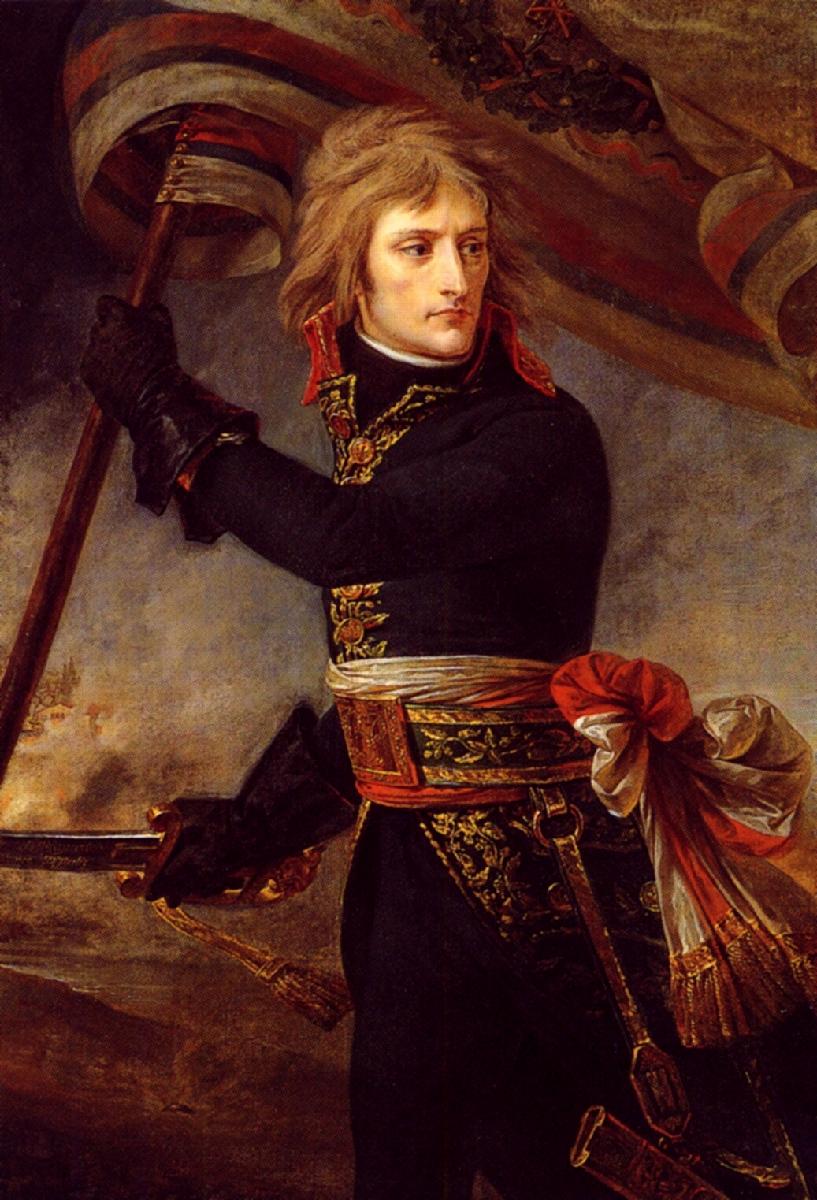
Napoléon Bonaparte at the
Bridge of Arcole – by Antoine-Jean Gros (c. 1801)
Musée du Louvre

|
|
Napoleon's anti-English strategy.
Napoleon now turned his attention to France's old enemy, England.
His intentions at first were to invade England - though further reflection
revealed that the French navy was not yet ready for such a feat.
He decided instead to aim at England's economic and imperial links with
Asia - with the intent of undercutting the English economy and replacing
English influence in Asia with French influence. His ultimate goal
was to eliminate the English hold over India by encouraging anti-English
Indian rebellion. More immediately his plan was to establish a strong
French base in Egypt - just astride the British trade route to the East.
The Directory was hesitant about the cost involved in such a major expedition - but ultimately glad to get Napoleon out of France, where his popularity easily exceeded theirs. In the late spring of 1798 Napoleon embarked for Egypt, capturing Malta as a resupply port along the way. He landed in Alexandria in July and was met by the army of the Mameluk ruler of Egpyt. At the 'Battle of the Pyramids' (July21) he crushed the Egyptians, scattering his opponents, some who moved southward up the Nile and others who moved to Syria to attempt to regroup there. But the British had been close behind Napoleon and met his Navy on August 1 to fight the 'Battle of the Nile.' This time it was the French who received the crushing - at the hands of Rear Admiral Horatio Nelson. This French defeat left Napoleon and his army stranded in Egypt. Nonetheless Napoleon continued his consolidation of French power in Egypt - despite continuing Mamaluk resistance. Much of the venture was actually an archeological expedition - as French scientists gathered Egyptian antiquities in great number (including the Rosetta Stone). Encouraged by news of Napoleon's defeat by the British Navy, the Ottoman sultan Selim III decided to mass an army to drive Napoleon out of his lands. But Napoleon decided that rather than wait for the sultan to gather an overwhelming force, he would move to the offensive first - striking out in February of 1799 toward Syria, capturing the key city of Jaffa along the way. But the fortress at Acre proved resistant, his supplies were rapidly dwingling, and his men were suffering from the plague. Thus in May Napoleon was forced to retreat back to Egypt. However, an Ottoman fleet sent out to Egypt to engage Napoleon in July was defeated by the French - helping Napoleon to recover some of his reputation lost the previous year at the Battle of the Nile. |

|
| Consul (or dictator) 1799
Hearing of mounting political confusion (and growing unpopularity of the Directory) back in France – and finding no further opportunities for glory in the Middle East – Napoleon decided to return to Paris. Upon his arrival (oddly enough, to a hero's welcome) he shut down the Council of Five Hundred and the Directorate, and named himself Consul of France ... confirmed in a new French constitution which in turn received in a national plebiscite almost total approval (a rather suspicious tally of 3 million in favor, only 1500 opposed). Emperor (1804)
There were numerous attempts to unseat, even at one point to assassinate, Napoleon ... and he used one such incident to move (with another highly approving plebiscite) to make himself "Emperor of France" ... with the rights of succession to the title on the part of any of his personal heirs. And so with the Pope in attendance, Napoleon had himself crowned French Emperor in December of 1804. He thus re-established in France the ancient principle of monarchy, with himself as an imperial monarch. The First French Empire was thus born. Reforms
In so many ways Napoleon brought France into modern culture. Besides modern military strategies, he introduced a new legal code – one which would outlive him as a model followed not only in France but widely in Europe (particularly in those countries where Bonapartist rule once held sway) and even in many other parts of the world. It replaced the complex mix of feudal customs with precise written rules applied equally to all citizens regardless of social rank. He reorganized the administration of France, ending its confusing maze of feudal districts, instead dividing France into 80 départements of more or less equal size, governed by prefects which he himself appointed, thus tightening Paris's control over the rest of France ... and giving it a truly national or French identity in replacement of the regional loyalties characteristic of traditional France. He freed up the sale or exchange of property ... and opened the trades or professions to anyone trained for the work – and not just to those born to specific guild families. He extended to Catholic France, brutalized by the Revolution, his Concordat of 1801 – restoring the Church and its priesthood to its place of religious privilege ... though he did not return to the Church properties seized during the Revolution. On the other hand, he shut down the Catholic Inquisition and ended the restrictions against Protestants and Jews. He liberalized France's divorce laws. He also pushed for the development of more secular public secondary schools (lycées). And he started France thinking in metric terms (though full conversion to the metric system would not take place until the mid-1800s). |
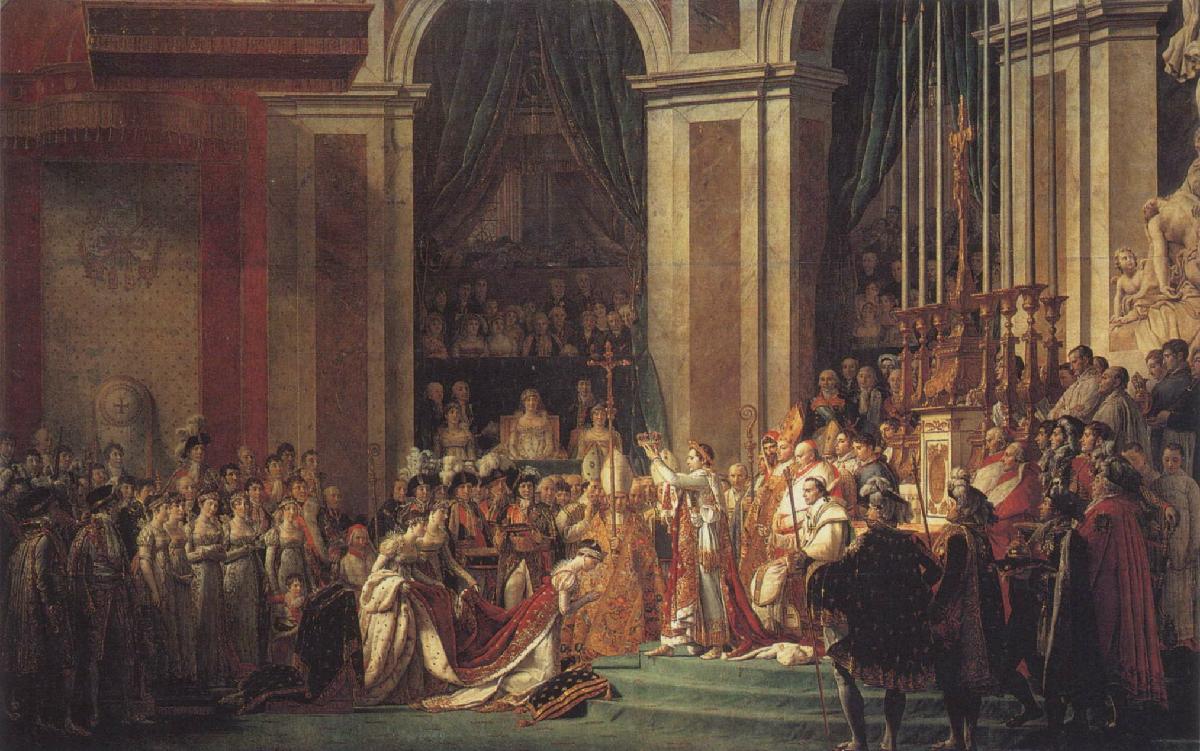

|
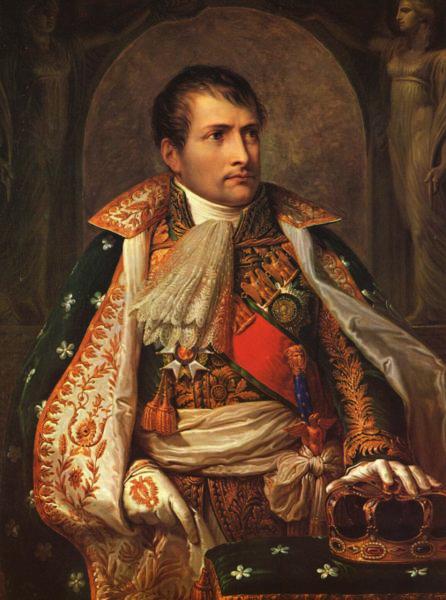
Napoléon on his Imperial
throne – Jean Auguste Dominique Ingres (1806)
Joséphine de Beauharnais – François Gérard (1808)
|
Josephine's first husband was guillotined during the Reign of Terror. Napoleon married her in 1796 ... but divorced her in 1810 – not having any children resulting from their marriage (she did have children by her first marriage ... including the future Napoleon III). Napoleon still loved her deeply ... and mourned her death deeply while he was still confined to the Island of Elba. Nonetheless, he married the Austrian Archduchess Marie Louise, in 1810 ... as a diplomatic move to improve French-Austrian relations (Marie-Louise would remarry after Napoleon's death in 1821). |
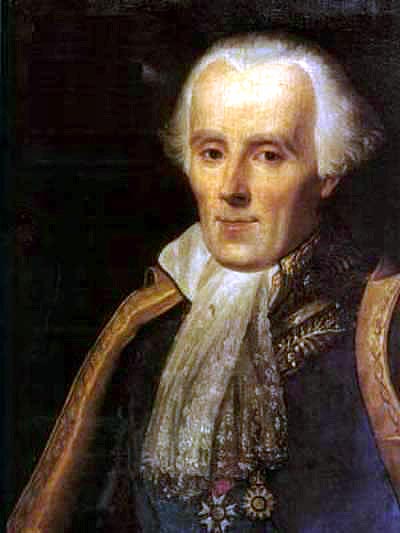
The French mathematician
and astronomer Pierre-Simon, Marquis de Laplace
(March 23, 1749 -
March 5, 1827)

|
| However it is in the conduct of his many wars that Napoleon is largely
remembered. He was hugely successful ... most of the time.
In 1800 he pulled success out of a near disaster at Marengo (Italy) and
won overwhelmingly at Hohenlinden (Germany) against the Austrians. In 1805, with the birth of a new round of war by a new coalition (the "Third") of Britain, Sweden, Russia, and Austria, things got off to a poor start for Napoleon when his own French-Spanish naval coalition was defeated by the English at Cape Finisterre (Spain), ending his hopes for an invasion of England by his Grande Armée. He then turned his army east towards the Austrians, crushing them at Ulm. But in the meantime his combined French-Spanish navies were again defeated – decisively – at Trafalgar (Spain) by the English under Lord Nelson. But the French were able to capture Austria's capital Vienna ... and then move on to destroy a combined Austrian-Russian army at Austerlitz before the end of the year. The resulting peace saw Napoleon remaking the face of central Europe, putting to an end the Holy Roman Empire and combining the hundreds of small but semi-independent German states into a Confederation of the Rhine. Napoleon was at the height of his glory at this point. In 1806 he marched against the ("Fourth") coalition of Prussia and Russia, crushing Prussia at Jena and Auerstedt. He then turned to face Russia, fighting to a stand-off at Eylau ... and then to an overwhelming defeat of Russia at Friedland. The Prussians lost half of their territory in Germany when Napoleon created the Kingdom of Westphalia and placed his brother Jerôme over it as king. With the Russian Tsar, Napoleon was kinder in his victory, hoping to create a friendship that could serve French interests in East Europe. |
Napoléon crossing the Alps
– Spring of 1800 – Jacques Louis David
Bonaparte led the French
Army over the Alps (actually on a mule!),
eventually defeating the Austrians
at Marengo.
Musée national du château
de Malmaison

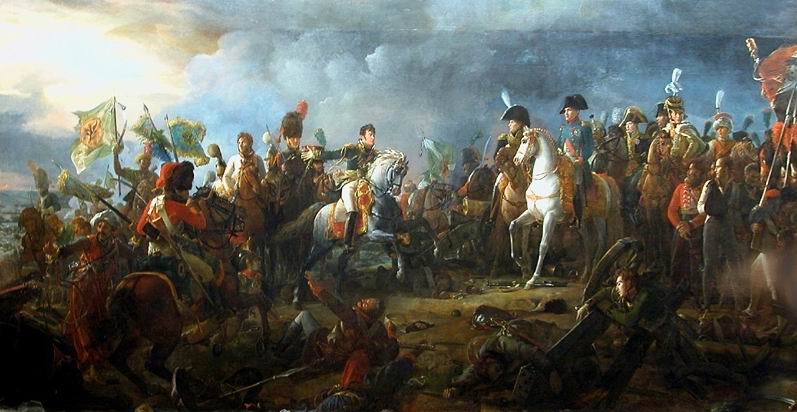
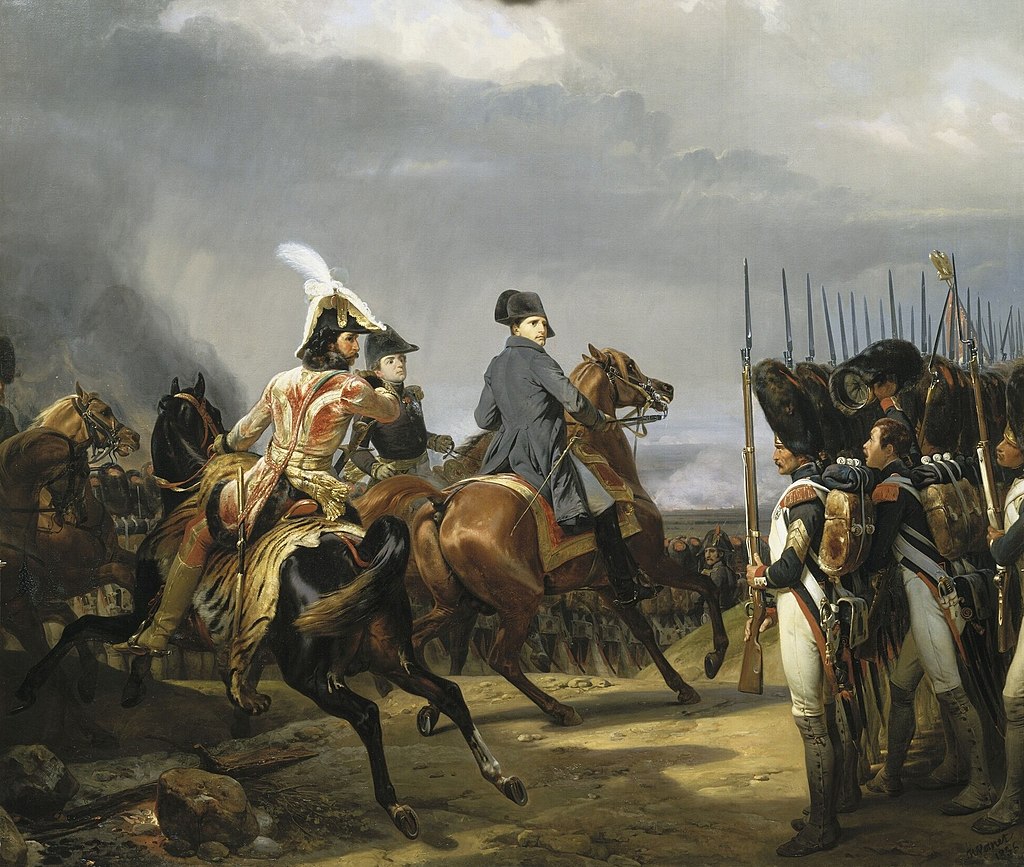
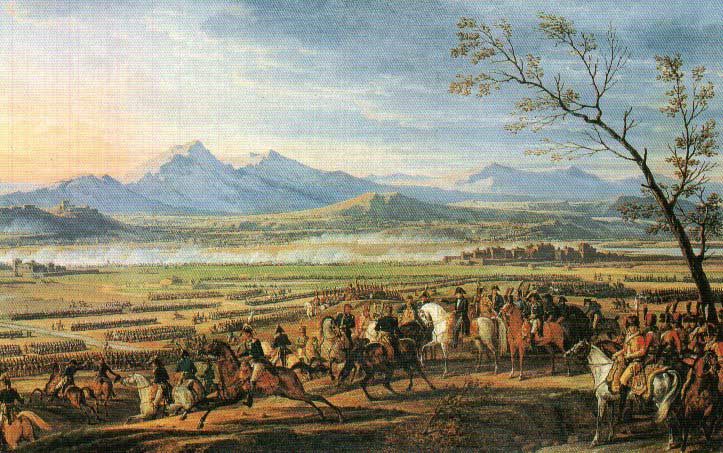

|
| He now focused his thoughts on Britain, attempting to tighten his
"Continental System" of a blocking of all commercial relations with
Britain on the European Continent in an effort to cripple the British
economy and thus force Britain to finally fall under his rule.
But his effort to discipline Portugal (which had not been honoring the
boycott) drew him into the Iberian Peninsula of Spain and Portugal ...
where Spanish sensitivities to French intervention in the region's
political affairs drew him into a draining round of local fights with
Spanish guerrilla bands. His appointing his brother Joseph as
King of Spain (1808) in the hope of getting on top of the situation
there only made matters worse. He was forced to position
permanently a huge portion of his army to hold things together in Spain
... while he faced continuing threats to France elsewhere.
Indeed, the British under Wellington would take advantage of Napoleon's
troubles elsewhere by sending their own troops to Spain and gradually
ending French control there. At this point (1809) Austria (part of the "Fifth" Coalition) re-entered the fight against France, actually defeating the French in a battle at Aspern ... but then being devastated by the French in a second engagement at Wagram. Politically this resulted in a huge loss for Austria. But at least peace would reign in Europe for the next few years. |
King George III by Sir William
Beechey (1799–1800)
London, National Portrait
Gallery
William Pitt the Younger
- Attributed to Thomas Gainsborough (c. 1804)
Prime Minister 1783 –
1801; Chancellor of the Exchequer 1804 – 1806
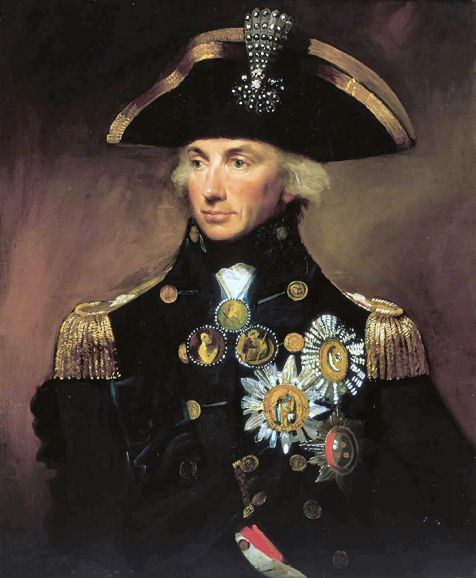
Horatio Nelson, 1st Viscount
of Nelson as Vice Admiral - by Lemuel Francis Abbott
Admiral Nelson shot on the
quarterdeck of Victory at the Battle of Trafalgar - (October 21,
1805)

Arthur Wellesley, 1st Duke
of Wellington - by Robert Home (1804)
National Portrait Gallery,
London

|
| But the Russian Tsar was being pressured by his nobles to join with Britain in an offensive against the French ... in the hope of retaking Poland. Napoleon heard of these plans and instead decided to take the initiative. Thus in 1812 he headed a French army of nearly half a million troops into Russia. A big mistake! The Russians fell back instead of offering direct resistance to the invaders (except at bloody Borodino) destroying their own crops and animals to keep the French from securing food for their troops. Napoleon made it all the way to Moscow just as the harsh Russian winter set in ... finding nothing in this abandoned and burned-out city to mark this as a victory. The Russians simply would not surrender. After five weeks of pointless occupation, and with political problems brewing back in Paris, Napoleon decided to withdraw. The retreat was so ruinous that less than one-tenth of his army made it back alive to France. |
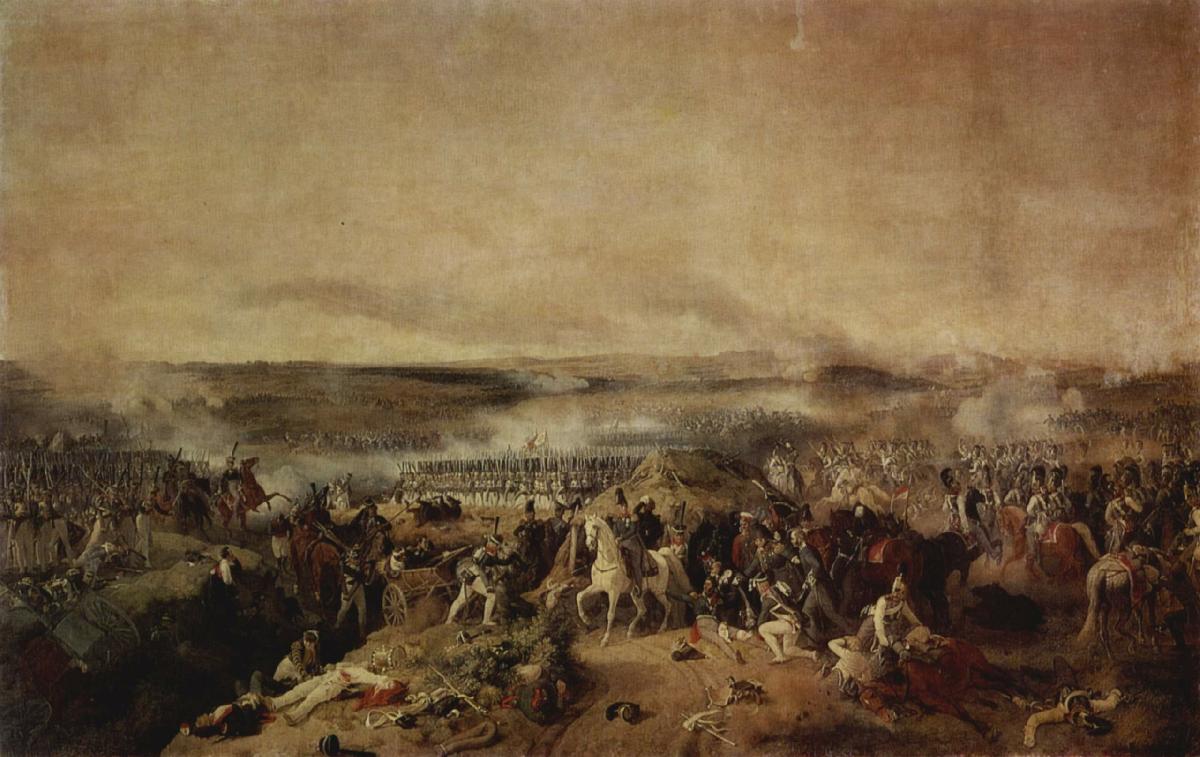
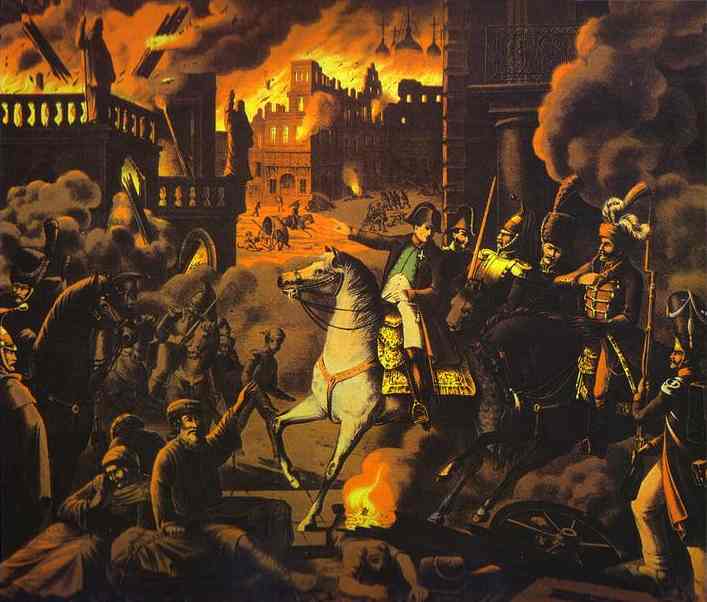
Napoléon's retreat from Moscow
– Adolph Northern
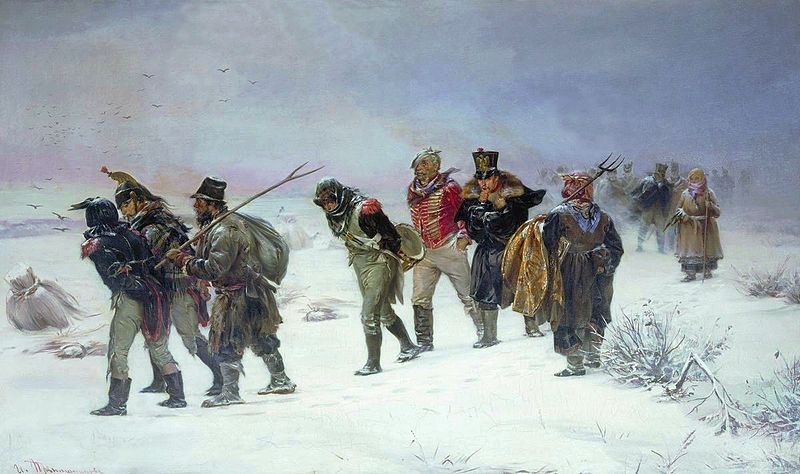
"In 1812" – Illarion
Prianishnikov
August 1813 - Napoleon's newly reassembled 350,000-man army defeats (but does not discourage)
a new anti-French coalition comprised at the time of Russian, Austria, and Prussia
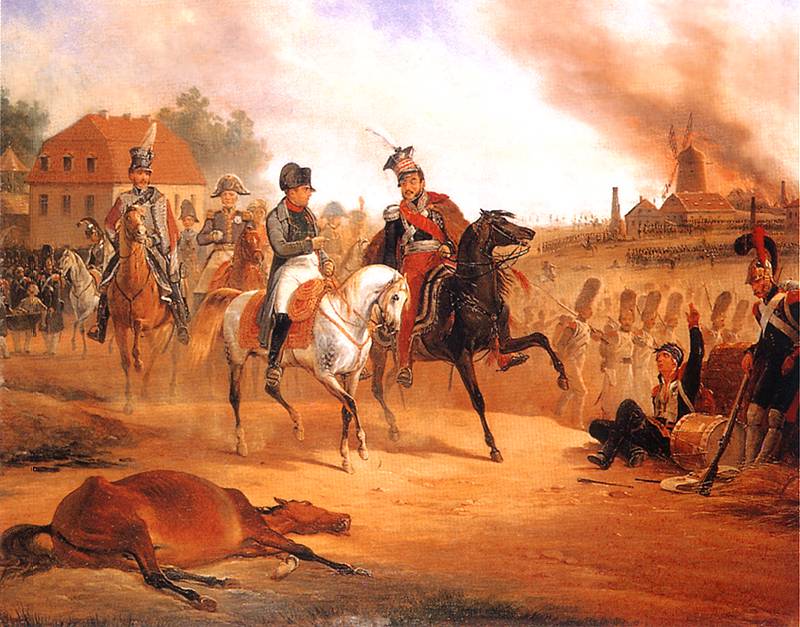
Napoleon and Poniatowski at Leipzig (October 18, 1813)

|
| The anti-French coalition was joined by Sweden ... and at the Battle of Leipzig, the French were defeated. In November, the allies offered Napoleon peace terms. He could keep his position as emperor in France and hold French territory in Belgium, the Rhineland ... but he would have to give up his position in Spain, the Netherlands and most of Italy and Germany. But Napoleon did not accept the terms ... until it became rather immediately obvious that his position had weakened deeply. But then the coaltion merely stiffened its terms against France ... and marched coalition troops even across French borders in January of 1814. Napoleon was able to hold off the coalition forces for a while. But by the end of March the coaltion had reached the outskirts of Paris. At the beginning of April it was obvious that Napoleon was a defeated monarch. |

Napoleon signs his abdication at Fontainebleau - April 11, 1814 - by Francois Bouchot
Palace of Versailles
|
Napoleon is exiled to the island of Elba in the Mediterranean, just off the coast of northwestern Italy ... where he is given the right to govern the small island as "emperor. However,
the following February (1815) he escaped Elba in order to return to
France and attempt a restoration of his power there. In the meantime, the Bourbon monarchy had been restored by the coalition, with Louis XVIII retaking the French throne in 1814. But Napoleon's return – and the military switching its loyalties to Napoleon – caused Louis XVIII to flee to the Netherlands. |

|
| In early 1815 news reached the allied delegates to the Congress of
Vienna that Napoleon had escaped from Elba and was gathering a new
French army in order to restore his French Empire. Britain,
Russia, Austria and Prussia were determined to put to an end forever
Napoleon's efforts to undo their work. By the summer, Napoleon
was ready to act against this new coalition, moving into (today's)
Belgium where outside the village of Waterloo he met the combined army
of Britain (under Wellington) and Prussia (under Blücher) ... and went
down in defeat. This time he was exiled to a small island (St.
Helena) in the middle of the Atlantic Ocean where he would remain until
his death six years later. |
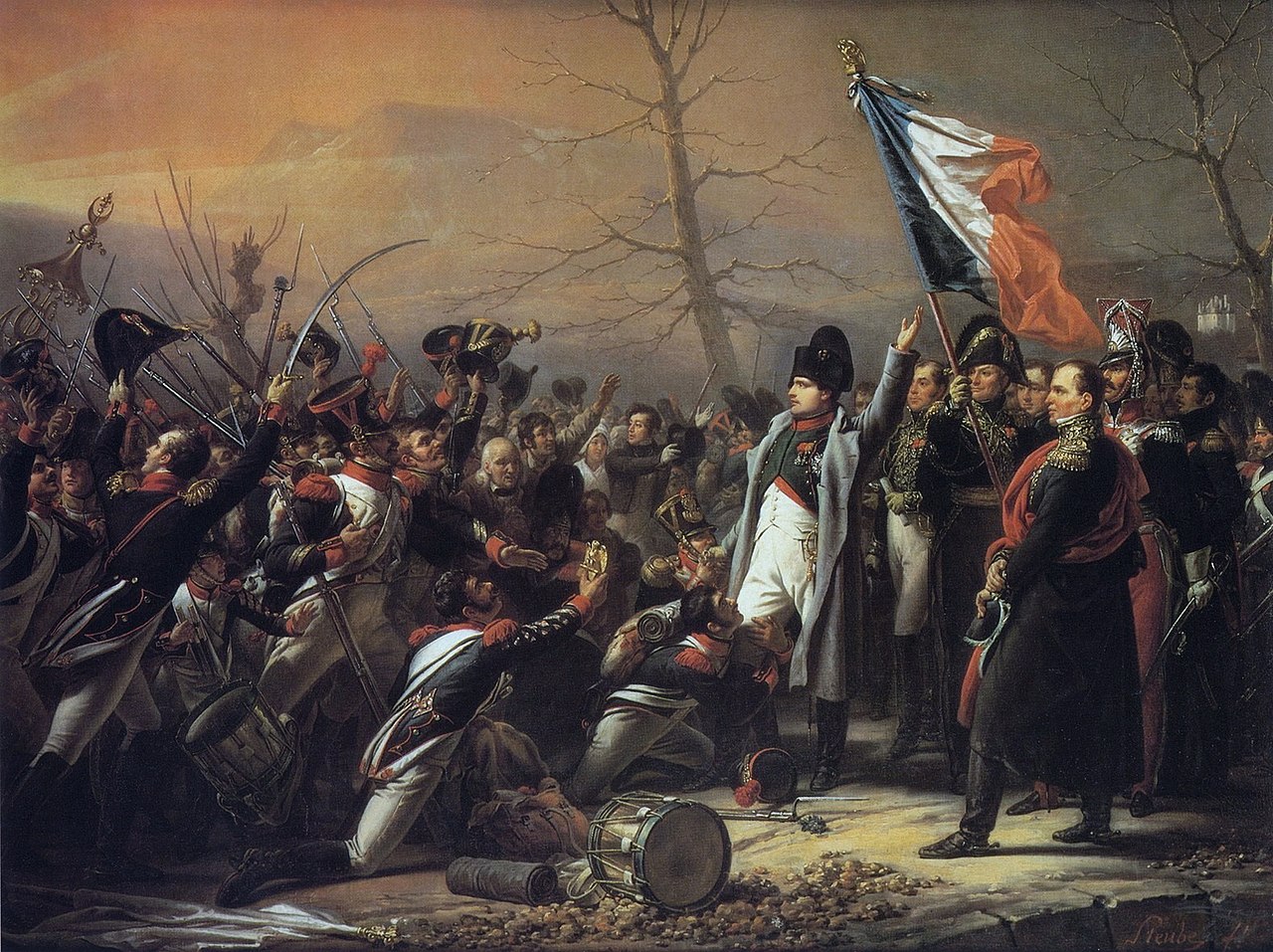
|
But Napoleon would hold his position in France only for "a Hundred Days" ... before coaliton forces (British, Dutch, and German) met Napoleon at the Battle of Waterloo, June 18, 1815. But French marshal Ney's cavalry was not able to break the ranks of British general Wellington's infantry square – despite numerous assaults. And the arrival of Blücher's Prussians merely swing the strength even more greatly to the coalition's side. |
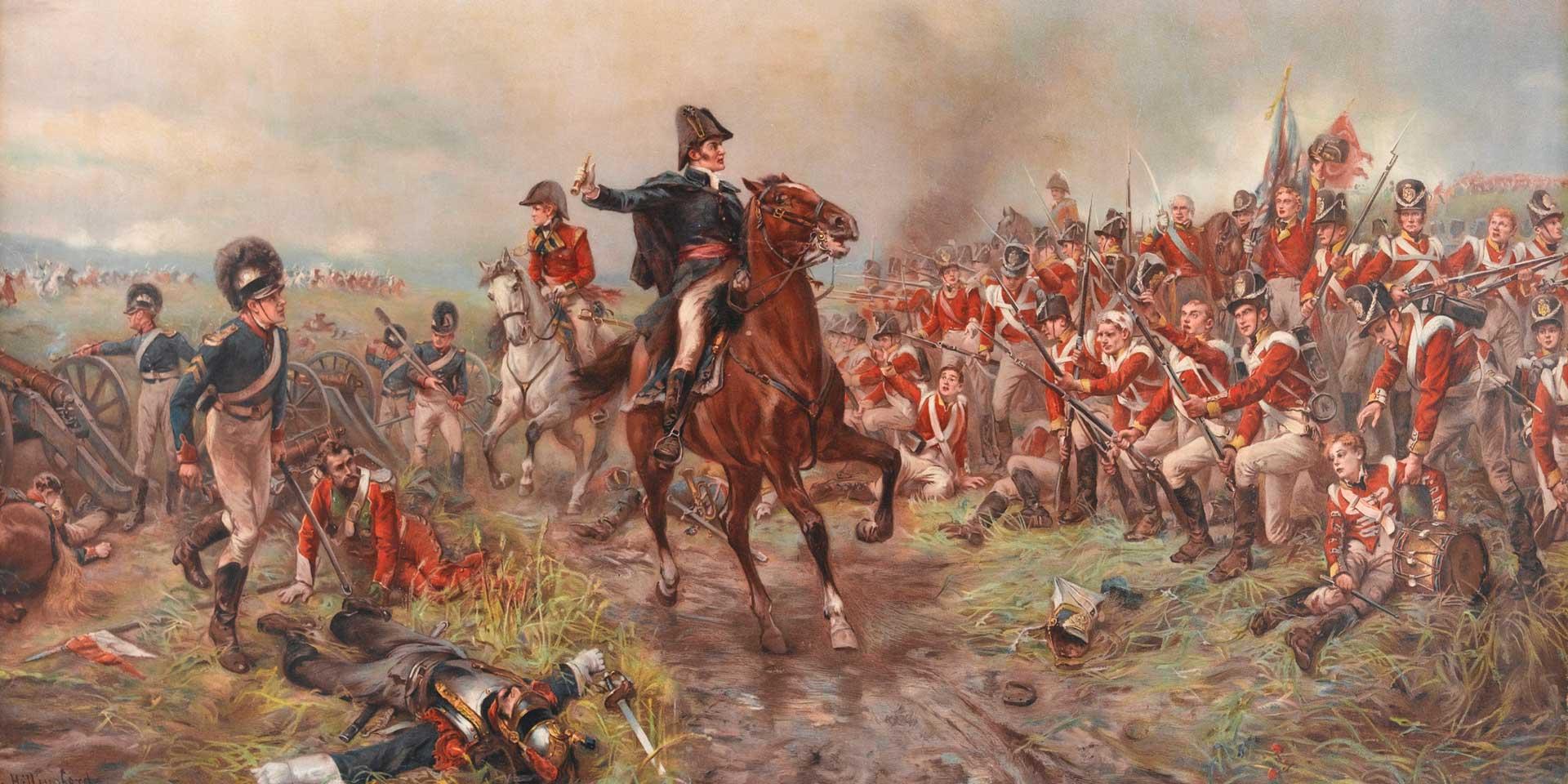
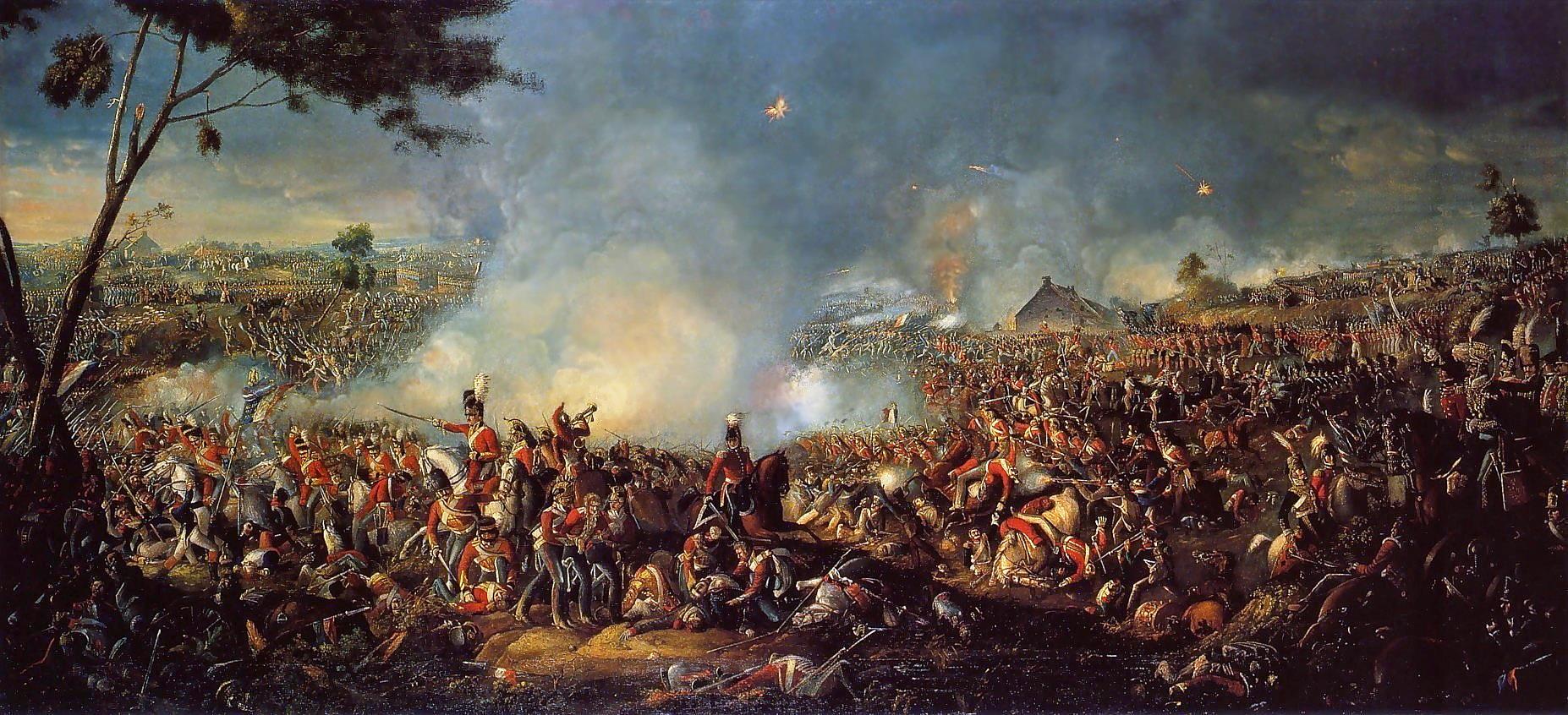
|
The
following day, the exhausted French were forced to fall back ... as the
coalition began its advance on Paris. Within a few days Napoleon
realized that further resistance was pointless (French support for his
rule was fading quickly) ... and finally announced his second
abdication on June 24th. There
was no path of escape available for Napoleon and on July 15th he
surrendered himself ot the British ... who then exhiled him to St.
Helena, a small island in the middle of the South Atlantic. There would
be no possiblity of escape this time. |
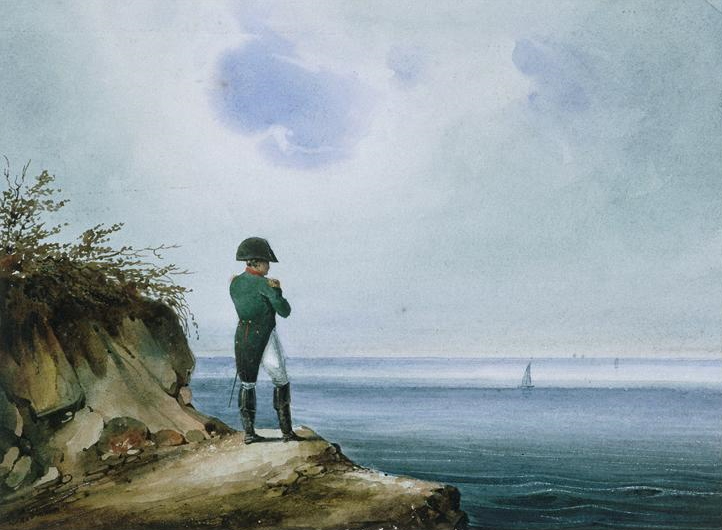

|
|

 Miles
H. Hodges
Miles
H. Hodges